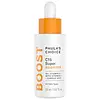What's inside
What's inside
 Key Ingredients
Key Ingredients

 Benefits
Benefits

 Concerns
Concerns

No concerns
 Ingredients Side-by-side
Ingredients Side-by-side

Water
Skin ConditioningAscorbic Acid
AntioxidantGlycerin
HumectantEthoxydiglycol
HumectantPPG-26-Buteth-26
Skin ConditioningMannitol
HumectantTridecapeptide-1
Skin ConditioningPalmitoyl Tripeptide-5
Skin ConditioningErgothioneine
AntioxidantSodium Hyaluronate
HumectantPentylene Glycol
Skin ConditioningPEG-40 Hydrogenated Castor Oil
EmulsifyingBisabolol
MaskingSodium Gluconate
Skin ConditioningDecylene Glycol
Skin ConditioningFerulic Acid
AntimicrobialOryza Sativa Bran Extract
Skin ConditioningTocopherol
AntioxidantPolyacrylate Crosspolymer-6
Emulsion Stabilising1,2-Hexanediol
Skin ConditioningPanthenol
Skin ConditioningSodium Phytate
Sodium Hydroxide
BufferingCitric Acid
BufferingPhenoxyethanol
PreservativeWater, Ascorbic Acid, Glycerin, Ethoxydiglycol, PPG-26-Buteth-26, Mannitol, Tridecapeptide-1, Palmitoyl Tripeptide-5, Ergothioneine, Sodium Hyaluronate, Pentylene Glycol, PEG-40 Hydrogenated Castor Oil, Bisabolol, Sodium Gluconate, Decylene Glycol, Ferulic Acid, Oryza Sativa Bran Extract, Tocopherol, Polyacrylate Crosspolymer-6, 1,2-Hexanediol, Panthenol, Sodium Phytate, Sodium Hydroxide, Citric Acid, Phenoxyethanol
Water
Skin ConditioningCarbomer
Emulsion StabilisingGlycerin
HumectantPEG-7 Glyceryl Cocoate
EmulsifyingButylene Glycol
HumectantAllantoin
Skin ConditioningPolylactic Acid
AbrasiveDisodium EDTA
Snail Secretion Filtrate
Skin ConditioningDehydroacetic Acid
PreservativeHydrolyzed Pearl
Skin ConditioningEthylhexylglycerin
Skin ConditioningParfum
MaskingAloe Barbadensis Leaf Juice Powder
Skin ConditioningAscorbyl Glucoside
AntioxidantCharcoal Powder
AbrasiveHippophae Rhamnoides Fruit Oil
Skin ProtectingPumice
AbrasiveTocopheryl Acetate
AntioxidantIsomalt
HumectantPhenoxyethanol
PreservativeBenzyl Salicylate
PerfumingGlucose
HumectantHexyl Cinnamal
PerfumingAloe Barbadensis Leaf Extract
EmollientCitronellol
PerfumingRosa Damascena Flower Oil
MaskingLimonene
PerfumingPelargonium Graveolens Flower Oil
MaskingBenzyl Alcohol
PerfumingPalmitoyl Tripeptide-1
Skin ConditioningPalmitoyl Tetrapeptide-7
Skin ConditioningButyrospermum Parkii Seedcake Extract
Skin ProtectingSodium Hydroxide
BufferingGeraniol
PerfumingLinalool
PerfumingCitrus Aurantium Flower Oil
PerfumingSodium Lactate
BufferingSubtilisin
Skin ConditioningLecithin
EmollientRhododendron Ferrugineum Leaf Cell Culture Extract
Skin ConditioningDipeptide Diaminobutyroyl Benzylamide Diacetate
Skin ConditioningPolysorbate 20
EmulsifyingSodium Benzoate
MaskingLactic Acid
BufferingCI 17200
Cosmetic ColorantWater, Carbomer, Glycerin, PEG-7 Glyceryl Cocoate, Butylene Glycol, Allantoin, Polylactic Acid, Disodium EDTA, Snail Secretion Filtrate, Dehydroacetic Acid, Hydrolyzed Pearl, Ethylhexylglycerin, Parfum, Aloe Barbadensis Leaf Juice Powder, Ascorbyl Glucoside, Charcoal Powder, Hippophae Rhamnoides Fruit Oil, Pumice, Tocopheryl Acetate, Isomalt, Phenoxyethanol, Benzyl Salicylate, Glucose, Hexyl Cinnamal, Aloe Barbadensis Leaf Extract, Citronellol, Rosa Damascena Flower Oil, Limonene, Pelargonium Graveolens Flower Oil, Benzyl Alcohol, Palmitoyl Tripeptide-1, Palmitoyl Tetrapeptide-7, Butyrospermum Parkii Seedcake Extract, Sodium Hydroxide, Geraniol, Linalool, Citrus Aurantium Flower Oil, Sodium Lactate, Subtilisin, Lecithin, Rhododendron Ferrugineum Leaf Cell Culture Extract, Dipeptide Diaminobutyroyl Benzylamide Diacetate, Polysorbate 20, Sodium Benzoate, Lactic Acid, CI 17200
 Reviews
Reviews

Ingredients Explained
These ingredients are found in both products.
Ingredients higher up in an ingredient list are typically present in a larger amount.
Glycerin is already naturally found in your skin. It helps moisturize and protect your skin.
A study from 2016 found glycerin to be more effective as a humectant than AHAs and hyaluronic acid.
As a humectant, it helps the skin stay hydrated by pulling moisture to your skin. The low molecular weight of glycerin allows it to pull moisture into the deeper layers of your skin.
Hydrated skin improves your skin barrier; Your skin barrier helps protect against irritants and bacteria.
Glycerin has also been found to have antimicrobial and antiviral properties. Due to these properties, glycerin is often used in wound and burn treatments.
In cosmetics, glycerin is usually derived from plants such as soybean or palm. However, it can also be sourced from animals, such as tallow or animal fat.
This ingredient is organic, colorless, odorless, and non-toxic.
Glycerin is the name for this ingredient in American English. British English uses Glycerol/Glycerine.
Learn more about GlycerinPhenoxyethanol is a preservative that has germicide, antimicrobial, and aromatic properties. Studies show that phenoxyethanol can prevent microbial growth. By itself, it has a scent that is similar to that of a rose.
It's often used in formulations along with Caprylyl Glycol to preserve the shelf life of products.
Sodium Hydroxide is also known as lye or caustic soda. It is used to adjust the pH of products; many ingredients require a specific pH to be effective.
In small amounts, sodium hydroxide is considered safe to use. However, large amounts may cause chemical burns due to its high alkaline.
Your skin has a natural pH and acid mantle. This acid mantle helps prevent harmful bacteria from breaking through. The acid mantle also helps keep your skin hydrated.
"Alkaline" refers to a high pH level. A low pH level would be considered acidic.
Learn more about Sodium HydroxideWater. It's the most common cosmetic ingredient of all. You'll usually see it at the top of ingredient lists, meaning that it makes up the largest part of the product.
So why is it so popular? Water most often acts as a solvent - this means that it helps dissolve other ingredients into the formulation.
You'll also recognize water as that liquid we all need to stay alive. If you see this, drink a glass of water. Stay hydrated!
Learn more about Water